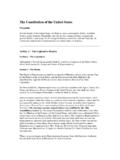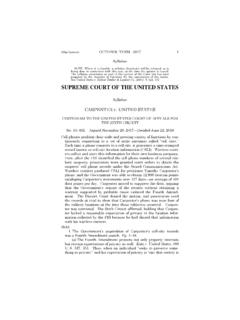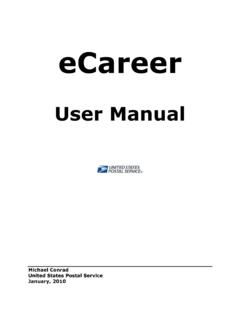Transcription of Lessons from PISA for the United States - oecd.org
1 Strong Performers and Successful Reformers in Education Lessons from PISA. for the United States Strong Performers and Successful Reformers in Education Lessons from PISA. for the United States This work is published on the responsibility of the Secretary-General of the OECD. The opinions expressed and arguments employed herein do not necessarily reflect the official views of the Organisation or of the governments of its member countries. Please cite this publication as: OECD (2011), Lessons from PISA for the United States , Strong Performers and Successful Reformers in Education, OECD Publishing. ISBN 978-92-64-09665-3 (print). ISBN 978-92-64-09666-0 (PDF).
2 Photo credits: Ainoa Getty Images John Foxx Corrigenda to OECD publications may be found on line at: OECD 2011. You can copy, download or print OECD content for your own use, and you can include excerpts from OECD publications, databases and multimedia products in your own documents, presentations, blogs, websites and teaching materials, provided that suitable acknowledgment of OECD as source and copyright owner is given. All requests for public or commercial use and translation rights should be submitted to Requests for permission to photocopy portions of this material for public or commercial use shall be addressed directly to the Copyright Clearance Center (CCC).
3 At or the Centre fran ais d'exploitation du droit de copie (CFC) at Foreword United States President Barack Obama has launched one of the world's most ambitious education reform agendas. Entitled Race to the Top , the agenda encourages US States to adopt internationally benchmarked standards and assessments as a framework within which they can prepare students for success in college and the workplace;. recruit, develop, reward, and retain effective teachers and principals; build data systems that measure student success and inform teachers and principals how they can improve their practices; and turn around their lowest- performing schools. But what does the top look like internationally?
4 How have the countries at the top managed to achieve sustained high performance or to significantly improve their performance? The OECD Programme for International Student Assessment (PISA) provides the world's most extensive and rigorous set of international surveys of the knowledge and skills of secondary school students. It allows one to compare countries on measures such as their average learning outcomes, their share of low-performing schools, the extent to which socio-economic background shapes learning outcomes and how consistently their schools deliver high quality outcomes. When OECD Secretary-General Angel Gurr a and United States Secretary of Education Arne Duncan met in April 2010, both felt that much was to be gained from a more detailed analysis of the policies and practices of those education systems that are close to the top or advancing rapidly.
5 This volume takes up the challenge, and is a first step towards a deeper understanding of education systems and policy trajectories through international comparisons. This volume is the result of a collaborative effort between the OECD, the National Center on Education and the Economy (NCEE) in Washington, government officials of the case study countries discussed, as well as international experts with extensive expertise in analysing the performance of education systems internationally. The report was prepared under the responsibility of the Indicators and Analysis Division of the OECD Directorate for Education, principally Andreas Schleicher and Richard Hopper, as part of OECD's new programme Leveraging Knowledge for Better Education Policies.
6 The underlying studies were carried out by the NCEE in consultation with the OECD, principally by Marc Tucker, Susan Sclafani, Betsy Brown Ruzzi and Jackie Kraemer. The principal authors of the chapters in this volume are: Introduction: Marc Tucker and Andreas Schleicher, NCEE and OECD;. Current performance of the United States : Andreas Schleicher; Japan: Marc Tucker and Betsy Brown Ruzzi, NCEE;. China: Kai-ming Cheng, University of Hong Kong, Hong Kong, China; Canada: Robert Schwartz and Jal Mehta, Harvard University, United States ; Finland: Robert Schwartz and Jal Mehta, Harvard University, United States ;. Germany: Marc Tucker and Betsy Brown Ruzzi, NCEE; Singapore: Vivien Stewart, Asia Society, United States ; Brazil: Susan Sclafani, NCEE; Poland: Susan Sclafani, NCEE; United Kingdom: Michael Day, Training and Development Agency for Schools, United Kingdom; Lessons for the United States : Marc Tucker and Andreas Schleicher, NCEE.
7 And OECD. Richard Hopper and Susan Sclafani established and maintained the contacts with the country experts and interview partners and co-ordinated the work. Vanessa Shadoian-Gersing, Niccolina Clements and Pedro Lenin Garc a de Le n of the OECD compiled relevant quantitative data and background information on each education system. The OECD PISA team provided information and diagrams to support PISA analysis contained in this volume. Elisabeth Villoutreix of the OECD co-ordinated the steps for publication. The officials and experts whom we interviewed for this study are listed at the end of each chapter. A group of experts oversaw the development of the conceptual framework, reviewed draft chapters, discussed preliminary findings and provided guidance to the authors.
8 These experts were Kai-ming Cheng: University of Hong Kong, Hong Kong; Michael Day: Department for Education, England; David Hopkins: University of London, England; Richard Hopper: OECD; Jackie Kraemer: NCEE; Barry McGaw: Melbourne Graduate School of Education, Australia; Elizabeth Pang: Ministry of Education, Singapore; Betsy Brown Ruzzi: NCEE; Pasi Sahlberg: CIMO Finland; Andreas Schleicher: OECD; Robert Schwartz: Harvard University, United States ; Susan Sclafani: NCEE; Vivien Stewart: Asia Society, United States ; Suzie Sullivan: NCEE; Marc Tucker: NCEE; Siew Hoong Wong: Ministry of Education, Singapore. The country chapter for Germany was reviewed by Eckhard Klieme from the German Institute of International Educational Research.
9 The other country chapters were reviewed and validated by the respective national authorities. Strong Performers and Successful Reformers in Education: Lessons from PISA for the United States OECD 2011 3. Table of Contents Chapter 1 A changing yardstick for educational 14. Overview.. 14. Framework for What is PISA and what can we learn from it?.. 18. How can PISA be used to help improve education systems?.. 20. Research methods employed for the country 21. Chapter 2 Viewing Education in the United States Through the Prism of Learning outcomes.. 26. Mean performance of United States ' 15-year-olds in the middle of the Relative shares of students at risk.
10 29. Relative shares of top-performing Equity in the distribution of learning 32. Equity in access to resources..32. Moderating the impact of socio-economic background on learning outcomes..34. The cost of the achievement The learning environment in the classroom and at 38. Teacher-student Disciplinary Teacher-related factors affecting the school How schooling is 42. Governance of school systems..42. School Public and private Selection of students into schools, grades and programmes..47. Assessment and accountability 49. Educational Assessment policies and 50. Accountability arrangements..51. 53. 61. Chapter 3 Ontario, Canada: Reform to Support High Achievement in a Diverse The Canadian education 66.














